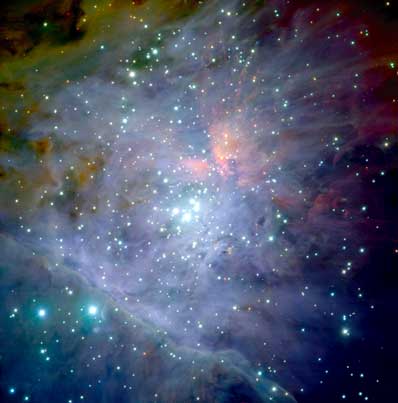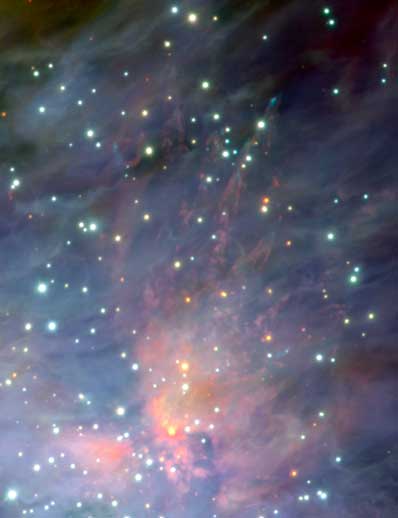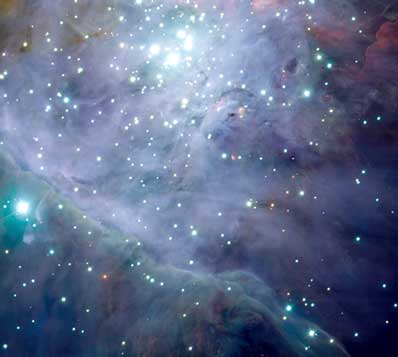
Remarkable new views captured of Orion Nebula
EUROPEAN SOUTHERN OBSERVATORY RELEASE
Posted: January 19, 2001
Orion the Hunter is perhaps the best known constellation in the sky, well placed in the evening at this time of the year for observers in both the northern and southern hemispheres, and instantly recognisable. And for astronomers, Orion is surely one of the most important constellations, as it contains one of the nearest and most active stellar nurseries in the Milky Way, the galaxy in which we live.

A color composite mosaic image of the central part of the Orion Nebula, based on 81 images obtained with the infrared multi-mode ISAAC instrument on the ESO Very Large Telescope (VLT) at the Paranal Observatory. The famous Trapezium stars are seen near the center and the photo also shows the associated cluster of about one thousand stars, about a million years old. Photo: ESO SEE FULL PAGE IMAGE
|
Here tens of thousands of new stars have formed within the past ten million years or so - a very short span of time in astronomical terms. For comparison: our own Sun is now 4,600 million years old and has not yet reached half-age. Reduced to a human time-scale, star formation in Orion would have been going on for just one month as compared to the Sun's 40 years.
Just below Orion's belt, the hilt of his sword holds a great jewel in the sky, the beautiful Orion Nebula. Bright enough to be seen with the naked eye, a small telescope or even binoculars show the nebula to be a few tens of light-years' wide complex of gas and dust, illuminated by several massive and hot stars at its core, the famous Trapezium stars.
However, the heart of this nebula also conceals a secret from the casual observer. There are in fact about one thousand very young stars about one million years old within the so-called Trapezium Cluster, crowded into a space less than the distance between the Sun and its nearest neighbour stars. The cluster is very hard to observe in visible light, but is clearly seen in the above spectacular image of this area, obtained in December 1999 by Mark McCaughrean (Astrophysical Institute Potsdam, Germany) and his collaborators with the infrared multi-mode ISAAC instrument on the ESO Very Large Telescope (VLT) at Paranal (Chile).
Many details seen in the new ISAAC image
Indeed, at visible wavelengths, the dense cluster of stars at the centre is drowned out by the light from the nebula and obscured by remnants of the dust in the gas from which they were formed. However, at longer wavelengths, these obscuring effects are reduced, and the cluster is revealed. In the past couple of years, several of the world's premier ground- and space-based telescopes have made new detailed infrared studies of the Orion Nebula and the Trapezium Cluster, but the VLT image shown here is the "deepest" wide-field image obtained so far.

A smaller, particularly interesting area of the above photo. This view shows the traces of a massive outflow of gas from a very young object embedded in the dense molecular cloud behind the Orion Nebula. Shards of gas from the explosion create shocks and leave bow-waves as they move at speeds of up to 200 km/sec from the source. Photo: ESO SEE FULL PAGE IMAGE
|
The large collecting area of the VLT and the excellent seeing of the Paranal site combined to yield this beautiful image, packed full of striking details. Powerful explosions and winds from the most massive stars in the region are evident, as well as the contours of gas sculpted by these stars, and more finely focused jets of gas flowing from the smaller stars.
Sharper images from the VLT
It is even possible to see disks of dust and gas surrounding a few of the young stars, as silhouettes in projection against the bright background of the nebula. Many of these disks are very small and usually only seen on images obtained with the Hubble Space Telescope (HST). However, under the best seeing conditions on Paranal, the sharpness of VLT images at infrared wavelengths approaches that of the HST in this spectral band, revealing some of these disks, as shown in below photo.
Indeed, the theoretical image sharpness of the 8.2-m VLT is more than three times better than that of the 2.4-m HST. Thus, the VLT will soon yield images of small regions with even higher resolution by means of the High-Resolution Near-Infrared Camera (CONICA) and the Nasmyth Adaptive Optics System (NAOS) that will compensate the smearing effect introduced by the turbulence in the atmosphere. Later on, extremely sharp images will be obtained when all four VLT telescopes are combined to form the Very Large Telescope Interferometer (VLTI). With these new facilities, astronomers will be able to make very detailed studies - among others, they will be looking for evidence that the dust and gas in these disks might be agglomerating to form planets.
Free-floating planets in Orion?
Recently, research teams working at other telescopes have claimed to have already seen planets in the Orion Nebula, as very dim objects, apparently floating freely between the brighter stars in the cluster. They calculated that if those objects are of the same age as the other stars, if they are located in the cluster, and if present theoretical predictions of the brightness of young stars and planets are correct, then they should have masses somewhere between 5 and 15 times that of planet Jupiter.

A small section of the observational data (in one infrared spectral band only, here reproduced in B/W) on which the first photo above is based. The field is centred on one of the famous Orion silhouette disks (Orion 114-426) (it is located approximately halfway between the center and the right edge of the third photo. The dusty disk itself is seen edge-on as a dark streak against the background emission of the Orion Nebula, while the bright fuzzy patches on either side betray the presence of the embedded parent star that illuminates tenuous collections of dust above its north and south poles to create these small reflection nebulae. Recent HST studies suggest that the very young Orion 114-426 disk - that is thirty times bigger than our present-day Solar System - may already be showing signs of forming itsown proto-planetary system. Photo: ESO
|
Astronomer Mark McCaughrean is rather sceptical about this: "Calling these objects "planets" of course sounds exciting, but that interpretation is based on a number of assumptions. To me it seems equally probable that they are somewhat older, higher-mass objects of the "brown dwarf" type from a previous generation of star formation in Orion, which just happen to lie near the younger Trapezium Cluster today. Even if these objects were confirmed to have very low masses, many astronomers would disagree with them being called planets, since the common idea of a planet is that it should be in orbit around a star".
He explains: "While planets form in circumstellar disks, current thinking is that these Orion Nebula objects probably formed in the same way as do stars and brown dwarfs, and so perhaps we'd be better off talking about them just as low-mass brown dwarfs" and also notes that "similar claims of "free-floating planets" found in another cluster associated with the star Sigma Orionis have also been met with some scepticism".
Here, as in other branches of science, claim, counter-claim, scepticism and amicable controversy are typical elements of the scientific search for the truth. Thus the goal must now be to look at these objects in much more detail, and to try to determine their real properties and formation history.
Comprehensive VLT study of Orion well underway
This is indeed one of the main aims of the present major VLT study, of which the image shown here is decidedly a good start and a great "appetizer"! In fact, even the present photo - that is based on quite short exposures with a total of only 13.5 min at each image point (4.5 min in each of the three bands) - is already of sufficient quality to raise questions about some of the "very low-mass objects". McCaughrean acknowledges that "some of these very faint objects were right at the limit of earlier studies and hence the determination of their brightnesses was less precise. The new, more accurate VLT data show several of them to be intrinsically brighter than previously thought and thus more massive; also some other objects seem not to be there at all".
Clearly, the answer is to look even deeper in order to get more accurate data and to discover more of these objects. More infrared images were obtained for the present programme in December 2000 by the VLT team. They will now be combined with the earlier data shown here to create a very deep survey of the central area of the Orion Nebula.

Another zoomed in view from the first photo. This view shows the delicate tracery created at the so-called Bright Bar, as the intense UV-light and strong winds from the hot Trapezium stars eat their way into the surrounding molecular cloud. Also visible are a number of very young red objects partly hidden in the cloud, waiting to be revealed as new members of the Trapezium Cluster. Photo: ESO SEE FULL PAGE IMAGE
|
One of the great strengths of the VLT is its comprehensive instrumentation programme, and the team intends to carry out a detailed spectral analysis of the very faintest objects in the cluster, using the VLT VIMOS and NIRMOS multiobject spectrometers, as these become available.
Only then, by analysing all these data, will it become possible to determine the masses, ages, and motions of the very faintest members of the Trapezium Cluster, and to provide a solid answer to the tantalising question of their origin.
The beautiful infrared image shown here may just be a first "finding chart" made at the beginning of a long-term research project, but it already carries plenty of new astrophysical information. For the astronomers, images like these and the follow-up studies will help to solve some of the fascinating and perplexing questions about the birth and early lives of stars and their planetary systems.

|
 |
 |
 |







|

